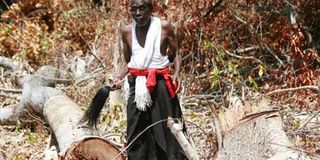Indigenous science can save the environment

Kaya elder Ali Mnyenze shows some of the indigenous trees that had been cut felled by a developer in Chale, which was a sacred place on the idyllic Chale Island in South Coast. PHOTO | FILE
What you need to know:
- Rivers, marshes and swamps were seen as important dwelling places for ancestors since various species of plants and animals thrived in them. Various bird species were also highly regarded and their habitats were protected.
- The Kigelia Africana tree locally known as the Edodoi, was believed to be an effective cure for mumps, and thus was never felled carelessly.
- Up to 98 per cent of the respondents surveyed during the study were aware of the existence of indigenous environmental systems, but the use of this knowledge has declined over time.
The use of totems and protection of sacred places, coupled with gender and age restrictions for access to certain places, used to play a key role in conserving the environment.
Defined as indigenous science, this local knowledge was used by people in particular geographical areas and was developed through acculturation and kinship and handed down through oral tradition and cultural rites and rituals.
“Indigenous environmental knowledge made a contribution to the protection of the bio-physical environment for sustainable development,” says Professor Dominic Ayaa of the department of social development at the Daystar University in Athi River, who is tracking changes in community use and adherence to indigenous knowledge systems from the 1960s to the 2000s, to evaluate the effects of changes on the quality of the environment. He was the lead researcher in a study which examined how indigenous science saved flora and fauna in Busia County.
However, the findings of the study published in the African Journal of Environmental Science and Technology, revealed that some of these practices have declined post-independence.
COMMON KNOWLEDGE
Prior to independence, the practice of ensuring that certain spots including burial sites, places for ceremonies such as taking oaths, appeasing of evil spirits, cleansing of members infected by contagious diseases or members believed to have committed serious crimes such as murder and adultery, places inhabited by clan gods and medicine men, were protected.
The conservation of water sources and vegetation was protected through rules that ensured their sustainability. More important were the shrines, caves and the forests covering the springs, which were never interfered with because of the belief that ancestors or evil spirits dwelt in such places.
Again, reptiles such as snakes, frogs and toads that inhabited ponds, rivers and wells were protected from harm due to the belief that they helped maintain and sustain these important water points.
Rivers, marshes and swamps were seen as important dwelling places for ancestors since various species of plants and animals thrived in them. Various bird species were also highly regarded and their habitats were protected. The Kigelia Africana tree locally known as the Edodoi, was believed to be an effective cure for mumps, and thus was never felled carelessly.
Up to 98 per cent of the respondents surveyed during the study were aware of the existence of indigenous environmental systems, but the use of this knowledge has declined over time. For example, the use of totems has declined 73 per cent, prohibited spaces have declined 86 per cent, enforcement of age and gender restraints reduced by 85 per cent and protection of sacred places has declined by 90 per cent. As a result, there has been an obvious destruction of the environment.
In 1992, the UN Conference on Environment and Development (UNCED) highlighted an urgent need for developing mechanisms to protect the earth’s biological diversity through indigenous knowledge.
Agenda 21 of the UNCED conference emphasised the need for governments to incorporate indigenous environmental management knowledge systems into contemporary socio-economic development programmes in order to attain sustainable development as per the treaty.


